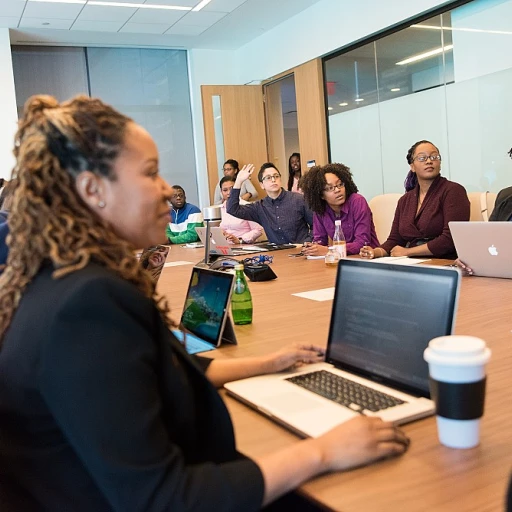
Defining Implicit Bias in the Workplace
Recognizing the Unseen Influences
Implicit bias in the workplace refers to the unconscious attitudes or stereotypes that affect our understanding, actions, and decisions. These biases can manifest in various ways, often unwittingly influencing how employees are hired, evaluated, and how teams collaborate. Recognizing implicit racial, gender, and other biases is the first crucial step towards addressing them.
Incorporating diversity, equity, and inclusion (DEI) practices can help organizations bring these biases to light and address them effectively. DEI initiatives are designed to foster a more equitable workplace where diversity is not only present but truly valued and integrated into the company culture.
While the healthcare sector is particularly sensitive to these influences, given its direct impact on patient care and outcomes, all industries benefit when implicit bias is tackled head-on. A focus on mental health and the care provided to older adults can also benefit from an inclusive approach. Bias training programs, culturally sensitive job descriptions, and tailored decision-making frameworks can mitigate these unconscious influences.
Diversity equity initiatives strive to create a level playing field by considering the specific needs of underrepresented groups, including women, racial minorities, and older adults. By addressing gender bias, organizational practices not only become more inclusive but also enhance public health outcomes.
For professionals interested in deepening their understanding of these concepts, pursuing a path to innovation through affordable online degrees in human resources is an excellent option. This ensures that HR professionals and teams are equipped to implement effective strategies, analyze data analytics, and enhance workplace equity inclusion proactively.
The Role of DEI in Addressing Implicit Bias
DEI as a Framework for Overcoming Unconscious Bias
In today's diverse workplace, Diversity, Equity, and Inclusion (DEI) serve as a powerful framework to identify and mitigate unconscious biases. These biases can subtly influence decisions related to job descriptions, team dynamics, and even healthcare delivery. DEI initiatives help create an environment where all employees, including women, older adults, and marginalized groups, feel valued and included.
DEI-driven bias training programs aim to raise awareness of implicit racial and gender biases that can affect decision making in the workplace. This training encourages employees to reflect on their preconceived notions and biases, ultimately promoting a more inclusive and equitable work culture. By addressing these issues head-on, organizations can improve mental health care and patient care by becoming more inclusive in their practices.
Fostering an Inclusive Culture
Implementing DEI practices is not just about hosting one-time events or trainings; it is an ongoing commitment to cultural transformation. Companies are adopting best practices that emphasize the importance of equity inclusion in both policy and everyday interactions. By actively reviewing job descriptions and team compositions, organizations can better ensure a balanced and fair workplace that reflects diverse perspectives and skills.
As DEI principles get integrated into every aspect of a company's operations, from recruitment to professional advancement, they significantly contribute to a healthier workplace environment. Understanding the definition of development organization in HR innovation can further aid companies in their DEI journey, ensuring that their strategies align with industry standards and innovative practices. For more insights, explore how a deep understanding of development organization can enhance HR innovations on this detailed resource.
Innovative Strategies to Combat Implicit Bias
Developing Strategic Approaches to Mitigate Implicit Bias in the Workplace
Dismantling implicit biases within the workplace requires a nuanced, multifaceted approach. These strategies aim not only to address immediate unconscious biases but also to foster an environment of ongoing growth and awareness.- Customized Bias Training: Instead of generic training sessions, organizations could benefit from tailoring bias training initiatives to reflect the specific needs and challenges of their workplace. This personalization ensures relevant and impactful advice that can resonate better with employees’ experiences.
- Inclusive Job Descriptions: The language utilized in job descriptions can unintentionally perpetuate gender bias or discourage diverse applications. Analyzing and revising job descriptions to be more inclusive can ensure that all qualified individuals, regardless of background, feel encouraged to apply.
- Promoting Diverse Leadership: By fostering diversity within leadership roles, biases can be challenged where decisions are being made. Diverse leadership teams can offer fresh perspectives, which are essential in promoting equity inclusion.
- Data-Driven Decision Making: Implementing data analytics to track diversity metrics and assess the effectiveness of DEI initiatives can illuminate areas of unconscious bias, allowing organizations to make informed decisions.
- Fostering Open Dialogue: Encouraging open communication about diversity, equity, and inclusion can help reduce stigma associated with discussing biases. Creating safe spaces where employees can discuss their experiences and challenges can lead to greater awareness and understanding across all levels of the organization.
- Emphasizing Mental Health: Addressing mental health care as a primary component of DEI can help mitigate stressors associated with workplace biases. Ensuring access to mental health resources for people, particularly older adults and underrepresented groups, can enhance overall workplace well-being.
Case Studies: Successful DEI Implementations
Highlighting Real-world Examples of DEI Success
Understanding implicit bias and the role of Diversity, Equity, and Inclusion (DEI) in addressing it can greatly benefit from examining successful implementations across various sectors. Organizations that have embraced DEI initiatives effectively have witnessed notable changes in their workplace environments, employee satisfaction, and overall innovation.
In the healthcare industry, for instance, embracing DEI has been linked to enhanced patient care and improved healthcare delivery. When healthcare teams are trained to recognize and mitigate their unconscious biases, particularly in areas such as gender and racial bias, it leads to a more inclusive care approach. This not only enhances health outcomes but also builds trust and rapport between patients and healthcare providers.
Transforming Decision Making and Job Descriptions
Incorporating DEI principles has also influenced decision-making processes within organizations. By utilizing data analytics, companies can identify patterns of unconscious biases in their hiring and promotion practices. Adjustments to job descriptions to include more inclusive language have been a significant advancement, attracting a diverse pool of applicants and eliminating barriers for underrepresented groups.
Furthermore, targeted bias training programs have proven successful in raising awareness among employees about their implicit racial, gender, or other unconscious biases. This awareness fosters a culture of equity inclusion and lays the groundwork for an environment where diversity is celebrated rather than just tolerated.
Equity Initiatives Across Sectors
Equity initiatives aren’t just confined to internal practices but also extend to the company’s social responsibility. Organizations that prioritize DEI and address bias at all levels – including the leadership – set an example beyond their doors, influencing industry standards and contributing to public health improvements.
For example, companies in public health sectors have developed integrity in their care delivery by ensuring that older adults, women, and other marginalized groups receive equitable health care without discrimination. These implementations underline how essential DEI is in fostering innovation within jobs traditionally hampered by historical biases.
Measuring the Impact of DEI on Innovation
Evaluating DEI's Influence on Workplace Innovation
Understanding the impact of Diversity, Equity, and Inclusion (DEI) on innovation necessitates a comprehensive look at various metrics and indicators. Measuring this impact involves evaluating how DEI initiatives shape not only the workplace but also thought processes and decision-making.- Data-Driven Insights: Utilizing data analytics to assess DEI outcomes can reveal patterns of representation, participation, and retention. By breaking down information across gender, race, and age, organizations can identify biases and address them effectively.
- Employee Feedback and Surveys: Collecting input from diverse groups within the workforce allows companies to gauge the efficacy of their DEI strategies in real-time. Employee insights can surface hidden aspects of unconscious biases, which might not be apparent through data alone.
- Team Dynamics and Collaboration: Observing how diverse teams interact and innovate serves as a practical indicator of DEI success. A more inclusive environment generally fosters creativity and innovation by enabling a variety of perspectives.
- Linkages to Business Outcomes: Establishing connections between DEI efforts and tangible business outcomes, such as improved healthcare delivery or enhanced public health strategies, can reinforce the value of DEI investments. For example, diverse teams in healthcare can address biases in patient care and provide better support for mental health and older adults.












